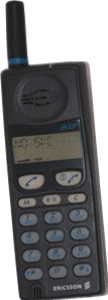Ericsson EH237

Award winning design
- Date launched: 1993
- Network: ETACS
- Form: Candy bar
- Size: 49(w)x130(h)x23(d) mm
- Weight: 200g
- Cost new: £382
- Can you use it today: No
- eBay value £20+
The Ericsson EH237 was the first of a new series of phones which was the mainstay of Ericsson design in the 90s. This design was a highpoint for Ericsson. It won many awards, including the coveted Caesar Award for 'Best Mobile Phone of the Year' in 1994, which was presented by Noel Edmonds at a special ceremony in March 1994. The EH237 was also liked by users, it won the What Cellphone 'Readers' Award.
Richard Lindahl of Malmo designed the new shape, known as 'Jane' Ericsson. 'Jane' was incidentally named after the actress Jane Seymour. Jane had all the hallmarks of an Ericsson design classic. Although some commentators thought the design a little industrial, others thought it was high tech chic. Ericsson designs from the past had defined the look of landline telephones for several decades. Could they do it again with mobile phones?
One of the judges on the panel for the Caesar Award for that year was Roger Bridgman, the Curator of Communications at the Science Museum in London. He was a big fan of the EH237 and thought it had great potential. It was amongst three phones he snapped up for the Science Museum's collection in 1994. The others two were the miniature Sony CM-R111 and one of the last of the bricks, the Motorola 8800X. The Ericsson sat between them in size and seemed to be the right size for a mobile phone at that time.
The Ericsson EH237 did indeed turn out to be a big seller. Ericsson sold over one million of them by March 1995.
Towards the end of the 90s, these phones started to show their age. As texting became more popular, the small screen's limitations were painfully exposed to users that had to scroll through long messages.
Ericsson kept this basic shape in production into the new century. However, by then advances in technology had left it behind.
Derivatives
Ericsson replaced the EH237 with an updated version the EH238 in 1995. The new phone swapped the distinctive blue buttons for more sober looking black ones. For classical music lovers, the EH238 had Beethoven's Fur Elise as a ring tone.
The EH237 spawned variants for other networks, including the GSM GH337 and the PCN version, the PH337.
Collectors' information
Values
These phones are quite rare. Expect to pay at least £20 for a good one.
Batteries and chargers
The batteries and chargers for the EH237 are the same as those used for some later digital phones, the GH337, PH337, PH388 and GA318, but not the GA628 or A1018/A1018s.
Resources
Article from the 'Independent' from 1994 about the EH237 - Communications move so fast that the Science Museum's specialist curator can barely keep up
Comments